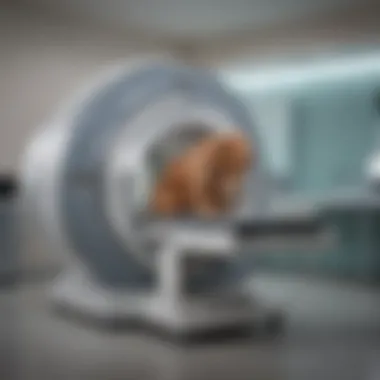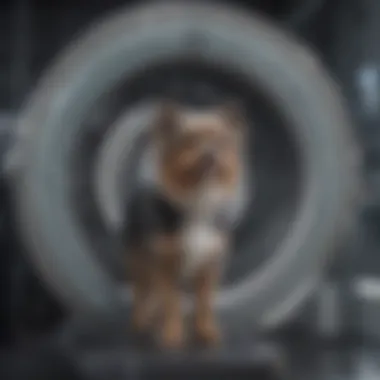Understanding Pet MRI Scan Costs and Factors


Intro
Pet MRI scans have transformed veterinary medicine, offering detailed imagery to diagnose a range of conditions. However, pet owners often find themselves grappling with the costs associated with these advanced scans. Understanding the factors that influence the price of pet MRI scans is essential for effective budgeting and planning. This insight is particularly valuable in navigating treatment options and insurance coverage.
Factors such as the type of MRI technology, geographic location, specific requirements of the animal, and additional services can significantly affect pricing. As veterinary practices evolve, so do the costs involved in delivering advanced care. Familiarity with these components will empower pet owners to make informed decisions concerning their pets' health.
Recent Advances
Latest Discoveries
In recent years, the field of veterinary diagnostic imaging has experienced noteworthy advancements. Research has contributed to a better understanding of the technology behind pet MRIs, leading to improved imaging quality and diagnostic capabilities. Moreover, findings have illuminated differences in costs associated with various imaging techniques and equipment quality.
Veterinary practitioners now have the ability to detect conditions earlier, enhancing treatment efficacy. Recognizing these latest discoveries can help pet owners appreciate the value of investing in quality MRI scans.
Technological Innovations
The introduction of high-field MRI machines has dramatically altered the landscape of veterinary diagnostics. These machines generate superior images, assisting veterinarians in making more accurate diagnoses. However, the technological sophistication also correlates with increased operational costs, which can be reflected in the price of scans.
Pet MRI services that employ state-of-the-art technology tend to have higher initial costs. Yet, the potential insights gained can lead to more effective treatment plans, which can ultimately save money on long-term care.
Cost Influencing Factors
The factors influencing pet MRI scan costs are multifaceted. Some of the primary aspects to consider include:
- Type of MRI Technology Used: High-field machines are typically more expensive than lower-field options.
- Geographic Location: Clinics in urban areas may charge more than those in rural settings due to different operational costs.
- Specific Needs of the Animal: Some pets may require sedation or additional procedures, increasing overall costs.
- Additional Services: Nexus services, such as anesthesia or post-scan consultations, can raise the bill.
"Informed pet owners can better navigate the complexities of veterinary costs by understanding the underlying factors influencing pet MRI pricing."
Finale
In navigating the costs associated with pet MRI scans, awareness and knowledge are key. Recognizing recent advances in technology and how they impact pricing will better equip pet owners in making financial decisions concerning their pets’ health. Further exploration of coverage options and what additional services may be necessary can ensure a fuller understanding for a prudent budgeting approach. Familiarization with these elements creates a foundation for making informed veterinary choices.
Overview of Pet MRI Scans
Understanding the costs associated with pet MRI scans is crucial for pet owners as well as veterinary professionals. MRI scans, or magnetic resonance imaging scans, are valuable diagnostic tools. They provide detailed images of soft tissues, facilitating the assessment of various health issues in pets. This section intends to elucidate the fundamental aspects of pet MRI scans and their relevance in veterinary practice.
What is a Pet MRI Scan?
A pet MRI scan is a non-invasive imaging technique used to visualize the internal structures of animals. It employs strong magnetic fields and radio waves to generate highly detailed images. Unlike X-rays or CT scans, MRI scans excel in capturing soft tissues, which is essential for diagnosing conditions related to the brain, spinal cord, muscles, and organs.
The procedure is generally safe and requires no ionizing radiation, making it a better option for pets who may need recurrent imaging. During the scan, the animal must remain still, often sedated, to ensure the accuracy of the images. The duration of the scan typically ranges from 30 minutes to over an hour. This focus on soft tissue imaging has made MRIs an indispensable tool in modern veterinary medicine.
Why Are Pet MRI Scans Used?
Pet MRI scans are utilized for a variety of reasons:
- Diagnosis of neurological disorders: They help detect conditions such as tumors, inflammation, or injury in the brain and spinal cord. These scans provide crucial information for treatment decisions.
- Evaluation of joint and soft tissue problems: MRI scans can identify ligament tears, cartilage damage, or muscle issues in pets, particularly useful in larger breeds predisposed to joint problems.
- Oncology assessments: For pets diagnosed with cancer, MRI scans are vital in determining the extent and progression of the disease, thereby guiding therapeutic strategies.
- Post-surgical evaluations: After orthopedic or soft tissue surgeries, MRI can assess healing and detect possible complications.
"MRI scans are essential for accurate diagnosis and treatment planning in oncology, neurology, and orthopedic cases."
In summary, pet MRI scans are a fundamental part of diagnostic imaging that significantly enhance a veterinarian's ability to evaluate and manage pet health issues. Understanding the reasons and benefits for using these scans is the first step for pet owners contemplating MRI for their animals.
Factors Influencing Cost


Understanding the factors that influence the cost of pet MRI scans is crucial for pet owners. It allows them to make informed decisions about diagnostic options for their companions. Knowledge of these elements can lead to better budgeting and more strategic planning, resulting in comprehensive veterinary care. Various factors will impact the pricing, and recognizing them can significantly affect the financial aspects associated with health care for pets.
Type of MRI Technology
The type of MRI technology used plays a significant role in the overall cost of a pet MRI scan. There are various types of MRI machines available, each with different specifications and capabilities. For example, high-field MRI machines provide superior image quality, which is essential for accurate diagnosis. However, this advanced technology often comes with higher service fees.
Furthermore, specialized MRI technologies that focus on specific areas of the body may incur additional charges. Using advanced imaging techniques, such as functional MRI or contrast-enhanced scans, are other variations that may not be readily available. Such exclusivity typically results in an increased cost for the service.
Geographic Location
Where the veterinary clinic is located is another critical factor that influences the cost of MRI scans for pets. Urban areas tend to have higher living costs, and this often translates into more expensive veterinary services. For instance, a pet MRI scan in New York City will likely cost more than one in a rural area like Kansas.
Local competition in veterinary services also plays a part. In regions with many veterinary clinics and specialist practices, prices may be more competitive, lowering the overall cost of services, including MRI scans. This means that researching various clinics within your geographic location can yield different price points and possibly save you money.
Animal Specific Needs
The needs of the animal themselves are paramount in determining the final cost of an MRI scan. Different species and breeds may require specialized treatment and handling, leading to variations in costs. For example, a large breed dog may need sedation for a successful MRI, which adds to the expense as sedatives and monitoring increase overall costs.
Additionally, pets with medical conditions that require more specialized imaging may incur higher fees. Such conditions involve additional preparation and often necessitate further testing alongside the MRI. Being aware of your pet's unique needs not only allows for more accurate estimations of the potential costs but also ensures optimal care.
Additional Veterinary Services
Finally, additional veterinary services may contribute to the total expense of a pet MRI scan. When an animal is brought in for an MRI, there are often preparatory examinations and follow-up consultations that will need to be considered. These may include consultations leading up to the scan, pre-scan blood tests, or anesthesia services. Each of these components adds to the overall price of the MRI scan.
Also, if a service involves a multi-step diagnostic process, such as performing an MRI followed by other procedures like biopsies or additional imaging, the added complexity can result in significantly elevated costs. Therefore, setting clear expectations with your veterinarian regarding necessary services and associated costs ahead of time is wise.
"Understanding the various factors influencing the cost of pet MRIs helps in informed decision-making and better financial planning."
In summary, the costs associated with pet MRI scans are influenced by various factors including the technology used, the geographic location of the clinic, animal-specific needs, and any additional veterinary services that may be required. Recognizing these components can aid pet owners in budgeting appropriately for these important health checks.
Cost Breakdown
Understanding the cost breakdown of pet MRI scans is essential for pet owners considering this diagnostic tool for their animals. It provides insight into what to expect financially and helps in budgeting for the procedure. Recognizing how various factors contribute to the total cost can aid pet owners in making informed decisions.
Additionally, having a clear idea of the cost structure allows for better discussions with veterinary professionals, ensuring that there are no surprises during the billing process. This awareness can also highlight the importance of selecting the right services tailored for their pet's specific needs.
Average Cost Estimates
On average, the cost of a pet MRI scan can range from $1,500 to $3,500. This range depends on factors such as the clinic's location and the type of the MRI technology used.
Most veterinary clinics will provide an estimate based upon these elements before the procedure. However, a deeper analysis reveals significant differences in pricing based on various factors:
- Location: Urban areas tend to have higher prices than rural locations.
- Technology: Advanced MRI machines may charge more due to their capabilities and efficiencies.
- Service Packages: Some clinics offer bundled services which may include additional consultations or follow-ups, impacting the total cost.
The outlined range is only a starting point. Pet owners must consult their veterinary clinics to get the most accurate and relevant estimates for their specific situations.
Variability in Pricing
Price variability in pet MRI scans is influenced by a multitude of factors. One significant aspect is the type of pet. For instance, MRIs for larger dog breeds can cost more than those for smaller pets due to differences in handling and process.
Another critical component is the diagnostic purpose. Scans for specific conditions may require more advanced technology or longer scanning times, thus increasing costs. Its also notable that MRI costs can differ widely between clinics, even within the same geographic area. Factors contributing to this include:
- Veterinarian Expertise: More experienced professionals may charge higher fees.
- Type of Facility: Specialty pet hospitals may set different price points compared to general veterinary practices.
- Local Economy: The economic conditions in specific regions can greatly affect prices.
Generally, it is wise to research various clinics to understand the potential costs involved and assess which facility aligns best with both the needs of the pet and the financial capabilities of the owner.


Types of Pets and Associated Costs
Understanding the costs associated with pet MRI scans requires a focus on the different types of pets. Each type of animal has unique anatomy, behavior, and health requirements that can influence the overall expenses. It is essential for pet owners to consider these specifics when budgeting for an MRI scan.
Dogs
Dogs are among the most common pets undergoing MRI scans. The cost for a dog MRI can vary significantly based on factors such as size, breed, and health condition. Generally, larger breeds may have higher costs due to the need for specialized equipment and protocols.
In addition to the basic scan cost, if a dog has special health concerns, additional diagnostics may be required, impacting the price. For instance, a dog with joint issues may need an extended scan focusing on specific areas. Owners should also consider that anesthesia is often required for dogs during an MRI, which adds another layer of cost.
Veterinary clinics may charge anywhere from $1,500 to $3,000 for a dog MRI, primarily based on these factors. Knowing the breed and any possible health issues in advance allows owners to gather proper estimates.
Cats
Cats also require careful consideration when it comes to MRI costs. Typically, the expenses for cat MRI procedures are similar to those of dogs, but some cats may need less sedation or a more straightforward imaging based on size and temperament.
The average cost for a cat MRI can range from $1,200 to $2,500. Factors influencing these prices include the clinic's location and the complexity of the specific scan required. For instance, cats with known health issues or behavioral challenges may incur higher costs due to additional services or prolonged monitoring.
Any cat owner should prepare for the possibility of additional expenses, such as consultations or follow-ups, which are often necessary after the MRI results.
Exotic Animals
Exotic animals pose unique challenges for veterinary practices, especially concerning MRI scans. Animals like reptiles, birds, or small mammals often require specialized equipment and handling techniques. This specialization can lead to higher costs.
Due to limited facilities that can perform MRI scans on exotic pets, prices may vary widely but can often exceed typical costs for dogs and cats. An MRI for an exotic animal could range from $2,000 to more than $5,000 depending on the specific needs of the animal and the availability of specialized veterinary practitioners.
Owners of exotic pets should confirm the veterinary clinic's experience and capabilities in handling these animals to ensure safety and quality care, which may provide an added expense but is critical for proper diagnosis.
Understanding the type of pet and its specific needs can significantly impact the costs associated with MRI scans. This insight helps owners make informed decisions about diagnosing and caring for their pets.
Insurance Considerations
When navigating the realm of pet MRI scans, understanding insurance considerations is crucial for pet owners. Veterinary care can become unexpectedly expensive, particularly with advanced diagnostic techniques like MRI scans. By addressing how insurance can influence these costs, pet owners can make informed financial decisions.
Pet Insurance Coverage
Pet insurance can serve as a safety net, alleviating some financial burdens during critical moments. Not all insurance plans, however, offer coverage for MRI scans. It is imperative for pet owners to scrutinize their policy details to comprehend the extent of coverage. Commonly, comprehensive pet insurance plans may include diagnostic imaging such as MRI scans, but specific exclusions might exist.
Here are some points to consider regarding pet insurance:
- Pre-existing Conditions: Many pet insurance policies do not cover pre-existing conditions, which could affect a pet's eligibility for necessary scans. If your pet has a chronic condition, the likelihood of insurance coverage diminishes.
- Deductibles and Copayments: Pet owners should be aware of their deductibles, as expenses related to the scan might still require significant out-of-pocket payments before the insurance starts covering costs.
- Network Providers: Some policies restrict coverage to particular veterinary clinics or specialists. It’s beneficial to verify that your chosen clinic performs MRIs and accepts your insurance.
Thus, it is essential to read the fine print and engage in discussions with insurance representatives to ensure clarity around what is covered. Finding a policy that aligns with your pet's health needs can mitigate financial strain during emergencies.
Out-of-Pocket Expenses
Even with insurance, understanding out-of-pocket expenses is vital. These expenses can quickly add up, especially in the context of an MRI scan. Pet owners might face varied costs, leading to potential financial surprises. Here are a few factors that contribute to out-of-pocket spending:
- Consultation Fees: Initial consultations with a veterinarian may incur costs before any imaging takes place.
- Emergency Services: If the MRI is conducted as part of an emergency response, additional fees may exist.
- Anesthesia Costs: In many cases, pets need sedation or anesthesia for the MRI, which can significantly increase the total bill.
- Follow-up Visits: Post-scan examinations and additional tests or treatments may also contribute to the overall expenses, reflecting the necessity for thorough financial planning.
"Pet MRI scans represent a substantial financial commitment. Anticipating out-of-pocket costs can help avoid surprises and enhance financial preparedness."
In summary, navigating pet MRI scan costs involves understanding both insurance coverage and potential out-of-pocket expenses. By carefully examining these aspects and proactively planning, pet owners can ensure they are financially prepared for their pet's health needs.
Preparing for a Pet MRI Scan


When considering a pet MRI scan, preparation is a crucial step that can significantly influence the outcome and quality of the diagnostic process. This section highlights the importance of preparing for a pet MRI scan, focusing on the elements that ensure it runs smoothly. Proper preparation is vital not only for the safety and comfort of the pet but also for obtaining accurate and relevant results from the scan.
Consultation with Veterinarian
Before scheduling an MRI scan, a detailed consultation with a veterinarian is essential. The veterinarian will assess the pet's health history, conduct a physical examination, and discuss the reasons for the MRI. This dialogue helps determine the necessity of the scan, as well as any specific concerns that need to be addressed.
A veterinarian can also explain the MRI procedure, what the pet may experience, and how to alleviate any anxiety the pet might feel. This information is crucial. It allows pet owners to prepare their pets mentally and physically. Moreover, a veterinarian may recommend additional tests or pre-scan imaging, if relevant, which can affect the overall cost.
Pre-Scan Requirements
Understanding and following pre-scan requirements is important for a successful MRI scan. Here are some common instructions that veterinarians may provide:
- Fasting: Many veterinarians recommend that pets fast for a certain period, usually around 8 hours, prior to the procedure. This ensures the pet’s stomach is empty, which minimizes the risk of complications during anesthesia.
- Medication History: Owners need to inform their vet about all medications the pet is currently taking. Some drugs may affect the safety or imaging quality of the MRI.
- Behavioral Considerations: If the pet is particularly anxious, sedatives may be suggested. The veterinarian can prescribe appropriate medications to help calm the pet before the scan.
By complying with these pre-scan requirements, pet owners can ensure the safety and effectiveness of the MRI process, leading to more reliable diagnostics.
Important Note: Following the veterinarian's instructions can also prevent delays or the need to reschedule the MRI, which could ultimately incur additional costs.
What to Expect During the Scan
Understanding the scanning process is crucial for pet owners preparing their animals for an MRI scan. Familiarizing oneself with the steps involved can significantly reduce anxiety for both the pet and the owner, ensuring a smoother experience. Knowing what to expect also aids pet owners in making informed decisions and managing their pets' needs appropriately.
The Scanning Process
During the MRI scanning process, the animal must be placed within the MRI machine. This requires the pet to stay still, which may necessitate sedation, particularly for those who exhibit anxiety or difficulty remaining calm. Sedation is generally a safe option used to minimize movement and enhance image clarity. It is vital to discuss any concerns regarding sedatives with the veterinarian before the procedure.
The scanning itself can last anywhere from 30 minutes to an hour, depending on the complexity of the required scans. The environment is designed to be quiet, and the machine itself produces loud noises intermittently. Due to these factors, some pets may become anxious, emphasizing the importance of preparation prior to arrival at the facility.
Veterinary technicians or veterinarians are present in the examination area and monitor the pet throughout the scan. An everyday guideline is that pet owners are often not allowed inside the scanning room to reduce noise and movement, which could hinder the scanning process. However, assurances help keep the animal calm, facilitating a successful scan. Understanding the environment and the process can help mitigate concerns that arise prior to the MRI.
Post-Scan Follow-Up
After the scanning is complete, the pet will be moved to a recovery area for observation. How long this will take largely depends on whether sedation was used and how the pet responds upon waking. This recovery period is essential in ensuring the well-being of the animal as they regain full consciousness and recover from any anesthesia.
The veterinarian will review the scans and discuss findings with the pet owner. This communication is an important phase, as it paves the way for understanding any necessary follow-up treatments or interventions that may be required based on the imaging results.
Post-scan care might include:
- Monitoring the pet for any unusual behavior.
- Allowing the pet to hydrate or rest after the procedure.
- Scheduling a follow-up consultation to get detailed insights from the veterinarian.
"A pet MRI is just a tool, but it can provide vital insights into your pet's health status. The follow-up is where the actionable results begin."
To ensure proper recovery and understanding, communicating with veterinary staff is essential. Clear follow-up instructions will aid in post-scan care and provide peace of mind for the pet owner, ensuring a comprehensive understanding of both the procedure and the subsequent medical considerations. Overall, knowing what to expect during and after a pet MRI scan prepares owners for a smoother experience.
Ending
Understanding the costs associated with pet MRI scans is essential for pet owners. This article highlights the complex factors that influence these costs and provides valuable insights into the financial considerations involved.
Summarizing Cost Influences
- Type of MRI Technology: Different types of MRI machines may vary significantly in cost. High-field MRI systems are generally more expensive than low-field systems. The technological advancements in imaging can influence pricing as more sophisticated equipment is usually associated with better quality.
- Geographic Location: The location of the veterinary clinic greatly affects the overall cost. Urban areas may have higher prices due to increased overhead costs, while rural areas might offer more competitive rates.
- Animal Specific Needs: Veterinary recommendations often depend on the specific health condition of the pet. More specialized services or unique pet requirements can lead to additional costs. Conditions requiring more extensive imaging or sedation can further escalate expenses.
- Additional Veterinary Services: Accompanying services like consultations, anesthesia, or follow-up treatments could add to the total cost of an MRI scan. Understanding these extras is crucial for comprehensive budgeting.
Through recognizing these influences, pet owners are better equipped to manage their expectations and financial planning regarding MRI scans for their furry companions.
Final Considerations for Pet Owners
As pet owners prepare for an MRI scan, they should remain well-informed about potential costs. Here are some key takeaways:
- Research Local Options: Comparing local veterinary clinics can uncover significant variances in pricing and quality of service.
- Inquire About Insurance: It is essential to understand your insurance policy. Pets might have different coverage options that can alleviate the financial burden. Check if the insurance covers part or all of the expenses involved in an MRI scan.
- Plan for Additional Expenses: Beyond the MRI cost, prepare for other expenses like sedation or necessary follow-up consultations. This foresight can help avoid unexpected financial strain.
Ultimately, a clear grasp of MRI scan costs leads to more informed choices. Proper planning aids in ensuring that pets receive the necessary diagnostic care without significant financial stress.















